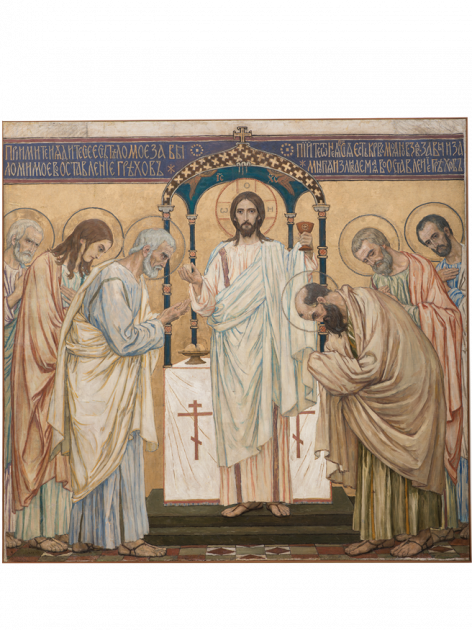THE EUCHARISTART. SKETCHES OF MOSAICS OF THE APSE OF THE CATHEDRAL OF ST.ALEXANDER NEVSKY IN WARSAW

The Eucharist (from the Greek “thanksgiving, grace”) is the essence of Orthodox worship. This was an eternal reminder of the sacrament of Jesus Christ's special consecration of bread and wine among his disciples, the apostles, on the eve of his arrest and crucifixion.
For V.M.Vasnetsov “the Eucharist” is an example of religious painting (Vasnetsov school), which combines style of images of old Russian Church art with refined forms of art Nouveau of the XIX–XX Centuries.
Contemporaries saw in Vasnetsov’s religious works psychologism and reflection of Russian medieval art and high aestheticism which the artist characterized: “The Beauty is the core of all forms in the Universe”.
The Orthodox Cathedral in Warsaw emerged at the end of the reign of Emperor Alexander III. The Project by L.N.Benoit was recognized the winner in the contest organized by a Special Committee for construction of the Cathedral. The project was approved by the Emperor in January of 1894.
The best artists of Russia headed by V.M.Vasnetsov were engaged in the works of decoration of the Cathedral. Made after his sketches 16 enormous mosaic compositions became the decoration of the new Orthodox Church. In total, there were around ten thousand works and objects of historic and artistic value in the Alexander Nevsky Cathedral.
Funds for construction of the Cathedral were raised by representatives of various classes all over the Empire. Archpriest John of Kronstadt contributed 13.500 rubles. Emperor Nicholas II for decoration of the altar of the Cathedral presented columns made of Jasper.
On May 20, 1912 the Church was consecrated in the name of the Holy Prince Alexander Nevsky. The Cathedral became the tallest building in Warsaw, thanks to majestic 70-meter bell tower, resembling the bell tower of Ivan the Great in the Moscow Kremlin. In the Cathedral accommodating 2.5 thousand people were celebrated the most important events: the anniversary of the Patriotic war of 1812; the 300th Anniversary of the House of Romanov.
During the First World War the Cathedral was turned into a garrison Catholic Church of the Holy Henry. Soon after Poland became an independent state at the end of 1918, the Warsaw magistrate ruled to abolish most of the Orthodox churches in the city, including the grandiose Church on the Saxon square. The demolition was carried out in 1924–1926 and required around 15000 explosions.
Only fragments of several mosaic panels from the Cathedral have survived to this day. The faces of the apostles from the composition “The Eucharist” that was located in the Central apse of the Cathedral now are located in the Temple of Mary Magdalene in Warsaw.
Pictorial sketches of Warsaw’s Cathedral mosaics have a great value for history of the new Russian religious painting of the beginning of the XX Century. The artist began, as he wrote, this “great and very important work” in the autumn of 1910, creating a graphic sketch. “The sketch is made somewhat in style of the “Eucharist” of the Kiev Sophia Cathedral,” noted Vasnetsov in a letter to the Committee for construction of the Cathedral in Warsaw.
